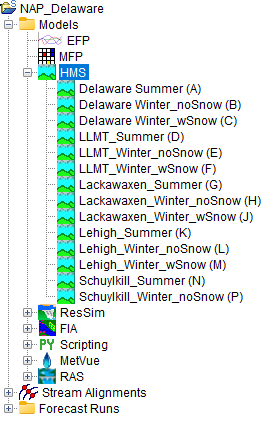Unlike real-time flood forecasting—which looks ahead to predict future hydrologic and hydraulic conditions—AFDR analysis is retrospective. It is performed after a flood event, with the primary goal of estimating how much damage was prevented due to existing flood control infrastructure. Because FDR is focused on what actually happened, it should rely only on observed precipitation data as input to HEC-HMS. Including forecasted data introduces unnecessary uncertainty and speculation, which can compromise the accuracy and credibility of the analysis.
Do not use the same HEC-MetVue alternative used for real-time CWMS forecasts, as it often includes both observed and forecasted precipitation. Instead, create a separate HEC-MetVue alternative that includes only observed data from the actual event, as shown below.

While you should use a different MetVue alternative, the existing HEC-HMS model from your real-time CWMS setup can often be reused for FDR analysis.
Most real-time HEC-HMS models include multiple alternatives tailored for different seasonal or antecedent conditions—such as:
- Summer
- Winter with snow
- Dry season
These alternatives help reflect how the watershed behaves under varying conditions throughout the year.
For AFDR, select the HEC-HMS alternative that best matches the conditions during the actual flood event. For example, if the event occurred in the summer, use the same summer alternative that was used in the real-time forecast. By aligning the seasonal or antecedent condition with the actual event, you ensure consistency and improve the reliability of your comparison between regulated and unregulated scenarios.
